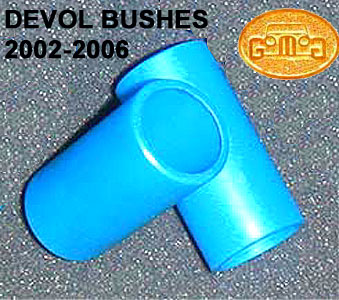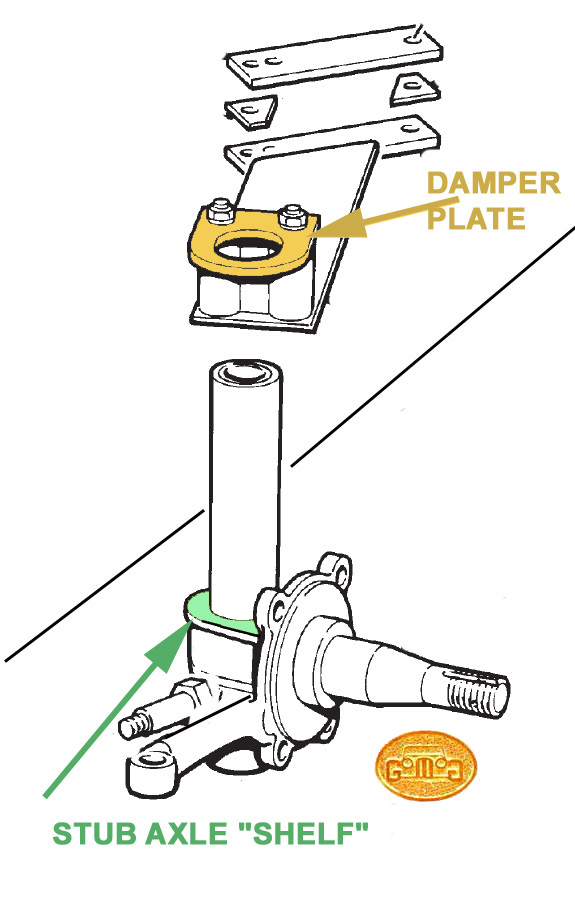GREASING MORGAN FRONT SUSPENSIONS
(cars from 2002 to 2006)
by Lorne Goldman
MAKE SURE YOU HAVE PICKED THE RIGHT GREASING ARTICLE
FOR YOUR MODEL YEAR ! YOUR CHOICES CAN BE FOUND HERE
UNDER "FRONT SUSPENSION GREASING".
| Please note that this configuration was only produced
for a short period and not long ago. Over time, the community will become
more familiar with them as experience grows. These pages will be updated
as warranted. |
 The
bushes fit in the stub axle tubes, one at the top and the other at the
bottom of the stub axle tube. As they do not fill the entire length of
the tube, a grease reservoir or "grease holding area" is formed between
the two bushes. As the stub axle slides up and down the kingpin, this reservoir
The
bushes fit in the stub axle tubes, one at the top and the other at the
bottom of the stub axle tube. As they do not fill the entire length of
the tube, a grease reservoir or "grease holding area" is formed between
the two bushes. As the stub axle slides up and down the kingpin, this reservoir  greases the kingpin (and therefore the bushes). The stub axle has a grease
nipple exactly adjacent to the middle of this reservoir to service and
fill this area periodically.
greases the kingpin (and therefore the bushes). The stub axle has a grease
nipple exactly adjacent to the middle of this reservoir to service and
fill this area periodically.
In 2002 and until sometime in 2006, the Works moved from
the earlier bronze bushes (1909-2002) to a new compound bush materiel called
Devol. If you have such a Morgan, you would be wise to read about them
in the Manual.
The annular
groove on the stub axle shelf, (created in 2000), was retained.
The main difference between greasing these cars and Morgans
from 2000-2002 is in the interval period between greasing. In this
case the Morgan Manual recommends 5000 miles and here they are almost right.
The Devol cars require less greasing than the bronze bushed cars. We recommend
intervals of 3000 miles. In any event, when the bushes require grease,
they announce that to you with squealing noises and groans. When you hear
that, you know you are not greasing enough or properly and the lack of
grease is starting to harm your bushes.
 Greasing
can be done with the car on the ground or on jack stands. A one hand "pistol"
greaser can be used. (When I am home, I use a powerful electric grease
gun equipped with a flex hose. The device effectively creates an extra
hand which makes the job easier.) The grease nipple angle can make it hard
to properly center the grease gun but the angle of the grease nipple can
be changed to suit you. or alternatively, buy an angled nose for your grease
gun. A slight angle will do.
Greasing
can be done with the car on the ground or on jack stands. A one hand "pistol"
greaser can be used. (When I am home, I use a powerful electric grease
gun equipped with a flex hose. The device effectively creates an extra
hand which makes the job easier.) The grease nipple angle can make it hard
to properly center the grease gun but the angle of the grease nipple can
be changed to suit you. or alternatively, buy an angled nose for your grease
gun. A slight angle will do.
1. Turn the steering wheel until you have the best angle
at the nipple,
2. Pump until the grease flows out under the damper plate
(which sits on the stub axle shelf.). (That takes a lot of pumps!)
| N.B. If the grease flows out the bottom of the assembly,
it is a sign that your car is due for a front end bush and kingpin renewal.
The reasoning for this is unassailable. As noted, Morgan stub axles are
made with a drilled passage to the shelf damper plate and it is this the
main spring sits upon (or with or without an intervening steering race).
However, the bottom bushes wear faster then the tops especially if you
are still using mild
steel kingpins. When these bushes become too worn, the grease will
flow downward around them and out rather than forced up through the grease
passage as planned. That much wear in the bottom bushes heralds the need
for bush replacement. |
| N.B. You no longer need to lift the damper plate as
you did with earlier cars (1936-2002) If
you see the grease exiting from the lower rungs of the Main Spring above
the axle, the likelihood is that you have not greased the underside of
the damper plate, a task as important as filling the reservoir. You have
either not bothered to lift the damper plate or have not done it sufficiently. |
4. Turn the steering wheel and do the other side.
5. Clean away any excess with a rag and, if necessary,
brake cleaning spray. If any grease gets on your adjacent brake rotors,
the effect on braking and steering is dangerous.
| PLEASE NOTE: I have received many
notes lately on the difficulties owners are having pumping grease into
the stub axles in front. At first I thought it was the grease gun they
chose, but I soon found the problem was even more basic. Many owners change
the stub axle grease nipple (zirk) for angled ones which allow an easier
time fitting their grease gun onto it. Sadly, they do not notice that the
threaded portion of the Morgan grease nipple is short..shorter than most
available. When they fit the new nipples they often thread them until they
are forced into the kingpin. This blocks the flow of grease despite the
use of eye-popping pressure. The front gets little of its needed grease
feed and the kingpin can be damaged. |
 The
bushes fit in the stub axle tubes, one at the top and the other at the
bottom of the stub axle tube. As they do not fill the entire length of
the tube, a grease reservoir or "grease holding area" is formed between
the two bushes. As the stub axle slides up and down the kingpin, this reservoir
The
bushes fit in the stub axle tubes, one at the top and the other at the
bottom of the stub axle tube. As they do not fill the entire length of
the tube, a grease reservoir or "grease holding area" is formed between
the two bushes. As the stub axle slides up and down the kingpin, this reservoir  greases the kingpin (and therefore the bushes). The stub axle has a grease
nipple exactly adjacent to the middle of this reservoir to service and
fill this area periodically.
greases the kingpin (and therefore the bushes). The stub axle has a grease
nipple exactly adjacent to the middle of this reservoir to service and
fill this area periodically.
 Greasing
can be done with the car on the ground or on jack stands. A one hand "pistol"
greaser can be used. (When I am home, I use a powerful electric grease
gun equipped with a flex hose. The device effectively creates an extra
hand which makes the job easier.) The grease nipple angle can make it hard
to properly center the grease gun but the angle of the grease nipple can
be changed to suit you. or alternatively, buy an angled nose for your grease
gun. A slight angle will do.
Greasing
can be done with the car on the ground or on jack stands. A one hand "pistol"
greaser can be used. (When I am home, I use a powerful electric grease
gun equipped with a flex hose. The device effectively creates an extra
hand which makes the job easier.) The grease nipple angle can make it hard
to properly center the grease gun but the angle of the grease nipple can
be changed to suit you. or alternatively, buy an angled nose for your grease
gun. A slight angle will do.